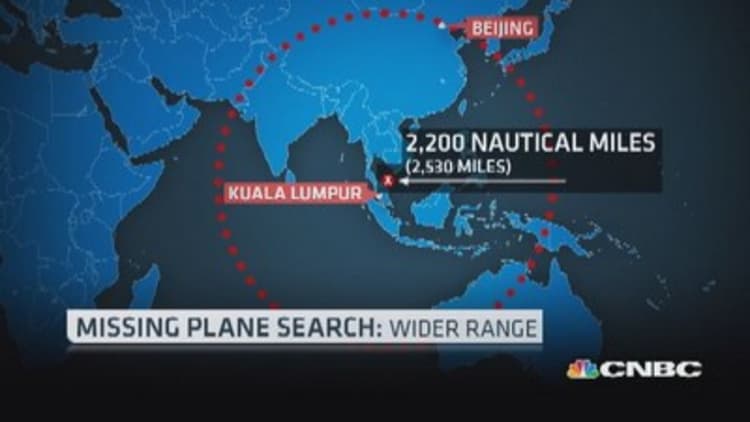
Malaysian authorities said the search for missing Malaysia Airlines plane MH370 had been extended on Friday, amid news reports that the plane could have been deliberately flown off-course towards the Andaman Islands.
A new report late Friday suggested the plane made erratic changes in altitude and course multiple times after losing contact with civilian radar, deepening the mystery over who had control of the plane and where it was headed. CNN also reported that a joint US-Malaysian government analysis calculated the plane likely crashed somewhere in the Indian Ocean.
Reports continue to trickle in about the whereabouts of the plane - which has been missing for almost a week. Reuters reported Friday that military radar-tracing evidence suggested the missing jetliner was flown by someone who had received aviation training across the Malaysian peninsula toward India's Andaman Islands.
Two unnamed sources told Reuters that the military radar plotted an unidentified aircraft heading through established aviation corridors used by commercial planes flying from Southeast Asia to the Middle East or Europe. The data suggest the plane may have been deliberately flown west taking it over the Andaman Islands, the sources said.
Meanwhile, the Malaysian transport minister held a press conference Friday, in which he said the search area had been widened and was "pushing further" into the South China Sea and Indian Ocean.
NBC News reported that US military assets were standing by to help search the southern part of the Bay of Bengal, much further west than past searches.
Inmarsat, the British satellite communications company, told the New York Times on Friday that it had recorded signals coming from the plane after it disappeared. It was the first confirmation that such signals existed, after days of reports and Malaysian government denials.
The Times later reported that the plane appears to have climbed above its approved altitude limit, descended and then turned before climbing again.
(Read more: Timeline of flight MH370)
"This is not a normal investigation..(and) forces us to look further and further afield," Seri Hishammuddin told reporters.
The minister also denied another media report - this time from The Wall Street Journal - that the jet had left a trail of data for several hours after it vanished.
"(This) report is not true," he said, adding that both Boeing and Rolls Royce agreed with this conclusion.
On Thursday, The Wall Street Journal reported that communication satellites received intermittent data "pings" from the Boeing 777 aircraft, giving the plane's location, speed and altitude for at least five hours after it disappeared from civilian radar screens, citing people who were briefed on the investigation.
The final satellite ping was sent from over water, at what one of these people called a "normal" cruising altitude, the Journal reported, adding that the people declined to say where specifically the transmission originated and that it was unclear why the transmissions stopped.
The automatic pings, or attempts to link up with satellites operated by Inmarsat PLC, occurred a number of times after the flight's last verified position, the people said, indicating that during that time, the jet carrying 239 people remained intact.
(Read more: Lack of MH370 news frustrates distraught relatives)
Malaysian Transport Minister Hishammuddin also said investigation was working more closely with U.S. authorities as the search for the plane continues.
The U.S. 7th Fleet deployed to search for the missing jet expanded its search to the Indian Ocean on Friday, William J. Marks, PAO (Public Affairs Officer), confirmed in an e-mail to CNBC.
Expanding the search area to the Indian Ocean would be consistent with the theory that the Boeing 777 may have detoured to the west about an hour after take-off from the Malaysian capital Kuala Lumpur en route to Beijing.
"It's my understanding that based on some new information that's not necessarily conclusive - but new information - an additional search area may be opened in the Indian Ocean," White House spokesman Jay Carney told reporters in Washington.
Still, another report surfaced on Friday contradicting speculation that the plane veered left upon its disappearance.
Seismologists at the University of Science and Technology of China said they detected an under-water event on March 8 shortly after the plane lost contact. The event was in an area where Vietnamese and Malaysian waters meet, about 70 miles northeast from where the plane lost contact. The team said it believed the incident could have been triggered by a plane crash.
Malaysian authorities on Thursday said the initial Journal report that the plane continued to fly for hours after its disappearance was inaccurate.
They maintain that the last definitive sighting of the aircraft on civilian radar screens came shortly before 1:30 a.m. on Saturday, less than an hour after taking off from Kuala Lumpur, as it flew northeast across the mouth of the Gulf of Thailand bound for Beijing.
Malaysian Airlines' CEO told a press conference Thursday that the last data transmission from the plane was recorded about 30 minutes after take-off. Ahmad Jauhari Yahya also said that Boeing and Rolls Royce did not receive any further data from the missing plane.
Efforts to find the missing plane have been hampered by the size of the search area, already the size of Portugal before it was expanded.
"We don't have any technology at this time to be able to remedy" not knowing where to search, said Robert Francis, senior policy adviser for aviation at Zukcert, Scoutt & Rasenberger and a former vice chairman of the U.S. National Transportation Safety Board.
"There are patches where the radar systems are not up to what one would see in Europe or North America," Francis said. "This is obviously an unfortunate time for this to happen because five years from now – or whatever it would be – there would be satellite abilities to stay in touch with aircraft much more precisely."
Follow us on Twitter @CNBCWorld


